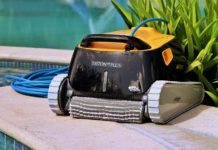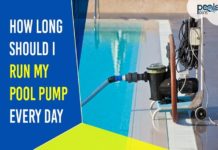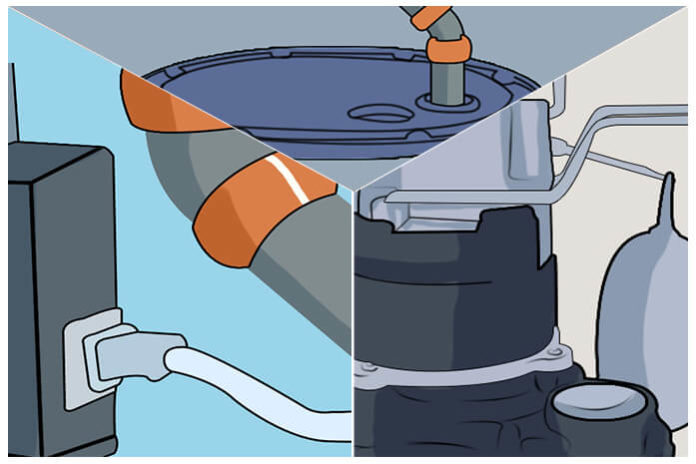You have to understand the importance of a clean pool for your enjoyment. After all, just having done isn’t enough. The water in your aboveground or in-ground pool starts decreasing in clarity and purity as time increases.
The problem is cleaning it. As it is a massive water body, you cannot just replace old water with new every time you want to enjoy a dip in the pool, as it can take several hours.
So, your best bet is to get yourself a pool pump that is an accessible swimming pool equipment for maintaining longevity and purity in your pool.
Their primary function is to make sure that water is circulated in the pool and does not rest for a more extended period to avoid algae and germs from spreading.
It also filters the water before it goes back into the pool. Therefore, you must invest in a good quality pump to ensure that it works perfectly for a period.
If you have already bought a pool pump, then installing it through this How to install a pool pump guide will help you out. Here is a list of the steps, which will help you in setting up your swimming pool pump correctly, in the right order.
Steps to install a pool pump for your aboveground swimming pool.
If you think of replacing your old pump with a new one then these steps, can of use to you too. The needed tools are Hacksaw, large pliers, 5/16 nut driver, screwdriver, unions or couplings.
Table of Contents
Step 1 – Shut the power off
- To start with the operation, you first need to shut off the power from the circuit breaker.
- See that the gears stop working. You can also use a multimeter to be sure you have flipped that correct breaker.
- You can close the water valves if your system is below the water level to prevent getting wet.
Step 2 – Remove the cover of the wiring
- Loosen all the wires after removing the protection of the wiring.
- To pull the wires out of the motor, you need to loosen the conduit connector, which would be on the outside of the motor.
- There must be a bare wire of copper connected to the motor, which is the bonding wire. You should remove this from the bonding lug. Along with it, bend it out of the way.
Step 3 – Break the Hacksaw
- Remove the pump with the help of the unions. Unions these days have turned out to be cheaper.
- You can use a cut location by using couplings. It will help you to cut again if needed in the future.
- You can think of moving the pump away from the valves, and If there is no option to cut it, you can choose to leave those still functioning and expensive valves.
- You should remove the PVC burrs and make clear vertical cuts through the pipes.
Step 4 – Break the large Channel Lock Pliers
- You can unthread the pipes out of the pump by strap wrenching or break the large channel lock pliers.
- These plumbing fittings can be reused if they had not been leaking previously.
- You must replace the threaded fittings, in case the pump leaks air or even If it is leaking water since there can be a possibility of threads being shrunk.
- These fittings can be termed as MTA’s or male threaded adapter. These can be available at a plumbing supplier or a home store.
Step 5 – Thread the MTA’s into the new pump
- You should cover the threads by using three wraps of Teflon tape in a clockwise direction.
- You can give it an extra seal by adding some silicon to the threads or with blue RTV’s.
- Make sure not to overtighten the pump housing as it can cause cracks. Hand the thread tight.
Step 6 – Replace the wires
- Before plumbing the pump in, you should replace the cables onto the new brought pump.
- You can get easier access to the back of the motor by standing the pump up on the front end.
- The ground wire must be connected to the green ground screw. The power leads must go into the terminal screws A and B, which one does not matter.
Step 7 – Line up the new pumps
- The next thing to be done is to line up the new pumps to the already existing pipes.
- The height of the incoming pipe won’t line up along with the setback of the effluent pipe too, in case the manufacturers or the pump models have been changed by you.
- In case your new pump is lower than the older, then you would have to use bricks or wood to raise its level.
Step 8 – Make the new plumbing connections
- You must use PVC primer on both, union and coupling and the pipe as well.
- In case, your pipe is dirty, scrub it in the right manner. Emery cloth or sandpaper can be used to clean it before you prime it.
- Then, you must glue the pipe and the fitting on a side at a time, liberally. That should be done within 30 seconds.
- Next, the fitting on the pipe is to be pushed in a twisting motion to its full depth. Then you should hold it in its place firmly for about 5 to 10 seconds.
Step 9 – Fill water in the pump
- Before you fill water in the pump, you should check for the presence of leaks around the base of the pump.
- The valves you had closed before the installation, they must be opened.
Step 10 – Turn on the pump
- Before turning on the pump, first, you should flip on the breaker.
- Next, the time clock is to be reset at the correct time. Turn on the pump with caution and notice if it gets loud or starts smoking, turn it off immediately.
Final Thoughts
Hence, these steps about how to install a pool pump will be beneficial in setting up the swimming pool pump.
In case you notice sparks or smoke, it might mean that the wires must be crossing or touching each other in the rear part of the motor. However, if the steps above are followed with precision, then there are decidedly fewer chances of this.
Also, you must ensure that after the proper setup, if non-swimmers or children are keen on swimming, then they must be accompanied and supervised.
You should think about minimizing the number of inflatable objects in the swimming pool as they do more harm than good. Children can get trapped in floating objects like a raft or many others.
Hence, you must take proper safety measures, especially when with children or the younger ones.









